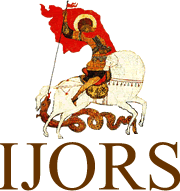
ISSN: 2158-7051
====================
INTERNATIONAL JOURNAL OF
RUSSIAN STUDIES
====================
ISSUE NO. 12 ( 2023/2 )
 |
ISSN: 2158-7051 ==================== INTERNATIONAL JOURNAL OF RUSSIAN STUDIES ==================== ISSUE NO. 12 ( 2023/2 ) |
THE MULTIETHNIC SOVIET UNION AND ITS DEMISE, By Ayse Dietrich*, Published by: Bloomsbury
Academic, Written by
Brigid O’Keeffe,
Year of Publishing: 2023. Subject Area: Soviet Union, Multiethnic empire, Book Type: Russian History
and Politics. Total Number of Pages: 134. ISBN: 9781350136779, paperback, $17,95.
Imperial
Russia was often described as a “prison house of nations” as put by Lenin. Non-Russian
ethnicities all suffered from some form of legal or cultural discrimination in
the empire.
When the Bolsheviks came to power, they
introduced a policy called Korenizatsiya
(indigenization, nativization) in such a volatile
region, where members of society still clung on to the bad memories of an oppressive
empire to reduce the hostility among the large non-Russian ethnic groups whose rights had
been ignored by the authorities during the empire, to raise the cultural level of the backward people to
the level of the Russian, to cultivate communist cadres for every nationality,
to make Soviet power attractive to non-Russians by presenting it in their own
language and by giving them an incentive to participate in the new system.
This
book is about the revolutionaries, the Bolsheviks who
seized power after the collapse of the empire and built the first socialist state in the
world in a multiethnic environment, and the
policies and ideological principles that shaped the Soviet Union as a
multiethnic empire. O’Keeffe examines why ethnic diversity was
fundamental to the nature of the Soviet Union and how it was governed, how the
people of the multiethnic Soviet Union were shaped and why this multiethnic
structure collapsed in 1991.
The book composed of seven chapters. In the first chapter the O’Keeffe talks about the
revolutionaries, and states that questions of ethnicity were never the Bolsheviks’ first concern as
Marxists since the Bolsheviks
who carried out the October Revolution themselves represented the diversity of
the multiethnic, multilingual, and multiconfessional
tsarist empire; even its leader Vladimir Lenin’s family had Russian, Jewish, German,
Swedish, and Kalymk origins, his comrade Leon
Trotsky’s family had Jewish roots and Joseph Stalin was Georgian. She talks
about how the Soviets dealt with the backwardness, how they embraced this multiethnic population and united
it; mobilized it for the building of socialism; and transformed the backward
and illiterate peoples of the empire into integrated Soviet citizens.
In the second chapter, the author examines
the fundamental principles of Soviet life and discusses how and why the Soviets
focused on ethnicity, how their obsessiveness with ethnicity question shaped
the course of Soviet history and the fates of the peoples until the end of the Soviet Union in 1991. She talks
about the policies the Bolsheviks exercised in non-Russian areas and states
that at the very beginning the Bolsheviks believed that their ethnic policies
had to attract non-Russian peoples to serve Bolshevik aims so that they would
not face a nationalist revolt against them and
at the same time to use them in
the service of building socialism to create communist unity through a strategic
nationality policy that would later transform the various nationalities into a
fraternal union of freely federated Soviet Republics of Russia. She states that
for the Soviets, ethnic diversity was a source of pride and a strength,
and a reflection of the
righteousness of the ideology of Soviet socialism.
In the third chapter, the author discusses the Soviet Union’s ethnic politics and what it meant in the
lives of Soviet citizens in the building of
socialism. She states that without mobilizing the diverse population of the
former tsarist empire, the Bolsheviks
could never have achieved their revolutionary goals. The author explores the varied experiences of different ethnic groups and
individuals during the Bolsheviks’ aggressive pursuit of their revolutionary
agenda.
In
the fourth chapter, the author focuses on the multiethnic Soviet Union at war
and under postwar reconstruction under Stalin, the ethnic dimensions of both
Soviet unity and disunity during WWII, the Great Patriotic War that created a
powerful force for unifying the Soviet people in a shared sense of purpose and
belonging, that fractured the multiethnic Soviet people along ethnic lines. The
author also discusses Russo-centric patriotism, ethnic cleansing and
deportations of non-Russian people.
In
the fifth chapter, the author explores the Friendship of Peoples as it was
lived by Soviet citizens in the postwar era and as it was shaped by the geopolitical
climate of the Cold War. She states that as Soviet society matured, so did some
of the tensions implanted in the Soviet’s ethnic politics such as homegrown
racism that flourished in the postwar era causing resentments and fissures that
threatened to destabilize the multiethnic structure of the Soviet Union.
The
sixth chapter discusses how Gorbachev’s glasnost, perestroika and
democratization policies that were implemented to set a wide-ranging
transformation of the Soviet Union’s politics, economy, and society in 1987
produced opportunities for nationalist movements in the republics, and dynamited
the already lagging Soviet economy, radically destabilized society, and shook
the foundations of the Soviet Union among them, the so-called Friendship of
Peoples.
The
seventh chapter examines the failure of Gorbachev’s reforms, how the Soviet
Union was dismantled from within, how Soviet ethnic politics failed to support
the Soviet state that was under the strain of Gorbachev’s destabilizing reform plan
and how they facilitated the Soviet Union’s fracturing along national lines.
The book is a well-written
work that presents an analysis of the multiethnic structure of the Soviet Union
and its dissolution. The primary audience for this reference book are researchers and academicians who are interested in the
field of Soviet Union’s ethnic politics.
*Ayse Dietrich - Professor, Part-time, at Middle East Technical University, Department of History and Eurasian Studies. Editor and the founder of the International Journal of Russian Studies (IJORS) e-mail: editor@ijors.net, dayse@metu.edu.tr, dietrichayse@yahoo.com
© 2010, IJORS - INTERNATIONAL JOURNAL OF RUSSIAN STUDIES